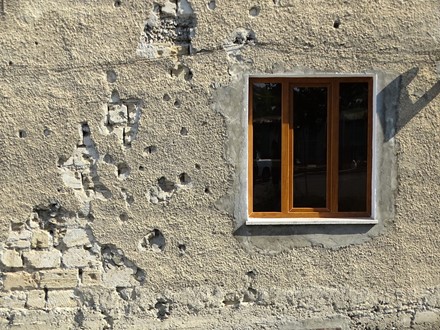BY ALEXIS POSTON
Photo by Adam Jones
In the early hours of 13 September 2022, Azeri Armed Forces launched a shelling attack against Armenian cities and towns along the Armenian-Azerbaijani borders, largely impacting the towns of Vardenis, Jermuk, Sisian, Goris, and Kapan.[1] Reports following the attacks revealed that Azeri forces were not just targeting Armenian military positions, as was claimed by Azerbaijan’s government,[2] but they were also targeting civilian areas.[3] These attacks on Armenia by Azerbaijan were the latest in a series of attacks spanning decades. From their time as part of the United Soviet Socialist Republics (USSR) and to gaining their independence as their own states, tensions have run high and consistently contribute to the increasing fragility of both states. The most recent attacks are, in part, responsible for Armenia’s rise from 97th to 93rd most fragile state this year, and even more significantly, the rise from 108th most fragile in 2019.
In the 1990s, both Armenia and Azerbaijan gained independence from the Soviet Union and Nagorno Karabakh also declared independence, despite remaining an officially recognized territory of Azerbaijan. These events became known as the First Nagorno Karabakh War, which ended in 1994 with Nagorno Karabakh and neighboring districts coming under Armenian control. From 1994 until 2020, tensions between Armenia and Azerbaijan remained high with intermittent incidents highlighting the possibility of another war breaking out between the two states. In September 2020, war broke out again with Azerbaijan attacking along the Nagorno Karabakh territorial line with Azerbaijan.[4] This six-week war ended with a trilateral ceasefire between Russia, Azerbaijan, and Armenia. The 2020 ceasefire agreement saw the return of Nagorno Karabakh to Azerbaijan and the establishment of Russian peacekeeping forces along the Lachin Corridor between Nagorno Karabakh and Armenia.[5]
Nagorno Karabakh has historically been a predominantly Armenian region, both ethnically and culturally, and is still largely Armenian.[6] While ethnic Azerbaijanis and other groups have also resided in the region, Armenians are largely considered to be indigenous to Nagorno Karabakh.[7] For decades, the Armenians of Nagorno Karabakh have been peacefully demonstrating and calling for their right to self-autonomy to be respected by Azerbaijan’s government.
The peace deal that followed the Second Nagorno Karabakh War saw Armenia ceding the territories of Nagorno Karabakh, which was met with anger from Armenians in both Armenia and within Nagorno Karabakh.[8] These protests called for Armenian Prime Minister Nikol Pashinyan to resign as Prime Minister. Despite these protests and the diminishment of public confidence in his leadership, which has contributed to an elevated score in Armenia’s State Legitimacy indicator (6.3 out of 10), he did not resign.[9] He in fact won a snap election following the war,[10] in part due to the support of Russia’s President Putin.[11]
Since the end of the Second Nagorno Karabakh War, Azerbaijan has regularly violated the ceasefire agreement, provoking firefights with Armenia along the border. As the ethnic violence continues, this distrust in Prime Minister Pashinyan does not bode well for the stability of Armenia. A blockade of the Lachin Corridor has cut Armenians in Nagorno Karabakh off from accessing medical care and their schools. Food supplies are running low. Power and gas in homes are being cut off by Azerbaijan’s government, which is impacting the living conditions. Armenian civilians of Nagorno Karabakh and surrounding regions along the Armenian-Azerbaijani border are threatened by Azerbaijan’s military and face violence if they try to leave Armenian territory within disputed areas, which former Human Rights Defender of Armenia Arman Tatoyan has described as a “deliberate policy of isolation.”[12]
Azerbaijan’s President, Ilhan Aliyev, and other Azerbaijani political leaders have been accused of using dog whistles and genocidal rhetoric when referring to Armenia and Armenians,[13] which is unsettling for the ethnically Armenian residents in Nagorno Karabakh. Azerbaijan’s government spreads Azerbaijani nationalist messages with anti-Armenian themes through state media.[14] Anti-Armenian sentiment has been prevalent in Azerbaijan’s “victory memorials,” following the Second Nagorno Karabakh War. Messages often depict Azerbaijan as the victims of radical Armenian nationalism, which can further exacerbate longstanding ethnic tensions and justify violence. Over time, this nationalism has resulted in the destruction of Armenian cultural and religious sites[15] and the oppression of Armenian language and culture in Nagorno Karabakh and other regions within Azerbaijan.[16]
The Lemkin Institute for Genocide Prevention[17] and the International Association of Genocide Scholars[18] have both highlighted the genocide risk factors against Armenians in Azerbaijan, Nagorno Karabakh, and Armenia. Additionally, the Lemkin Institute for Genocide Prevention, in their fourth Red Flag for Genocide update on Azerbaijan, pinpoint the incrementalization of genocidal processes and how Azerbaijan’s actions towards Armenians and Armenia fit within this understanding of genocide.[19]
In peace talks that have followed the ongoing violence in Nagorno Karabakh, several Western states have proposed and supported policies that largely favor Armenia giving up Nagorno Karabakh entirely to Azerbaijan in the name of peace and regional stability.[20] Geopolitical dynamics put Armenia at a disadvantage at the negotiation table, as powerful interests in the region are hesitant to openly oppose Turkey, who is an ally of Azerbaijan and has a long history of conflict with Armenia.[21] With a lack of direct action following the few resolutions passed by international organizations, such as the European Parliament and the International Court of Justice,[22] little is being done by other states to support Armenia.
There are numerous factors contributing to both Armenia and Azerbaijan’s instability, not least the threat of continued violence that jeopardizes ethnic Armenians within Nagorno Karabakh and Azerbaijan. As peace talks between Armenia and Azerbaijan continue, the international community has the opportunity to support genocide prevention in Armenia and Azerbaijan. Peacebuilding and accountability are crucial components of addressing state fragility in the South Caucasus region.
[1] https://evnreport.com/opinion/name-the-aggressor/
[2] https://www.crisisgroup.org/europe-central-asia/caucasus/armenia-azerbaijan-nagorno-karabakh-conflict/upholding-ceasefire
[3] https://evnreport.com/politics/azerbaijan-launches-large-scale-attack-against-armenia/
[4] https://eurasianet.org/as-fighting-rages-what-is-azerbaijans-goal
[5] https://www.bbc.com/news/world-europe-54882564
[6] https://www.cfr.org/global-conflict-tracker/conflict/nagorno-karabakh-conflict
[7] https://www.lemkininstitute.com/statements-new-page/statement-on-the-western-media-narrative-regarding-azerbaijan’s-september-13-attack-on-armenia
[8] https://foreignpolicy.com/2020/11/10/armenians-oppose-last-minute-peace-deal-azerbaijan-nagorno-karabakh/
[9]https://arka.am/en/news/politics/survey_reveals_sharp_drop_in_nikol_pashinyan_s_popularity_/
[10] https://www.theguardian.com/world/2021/jun/21/armenian-pm-claims-victory-parliamentary-election-rival-alleges
[11] https://www.aljazeera.com/news/2021/4/16/armenias-pm-faced-mass-protests-why-is-he-still-leading-polls
[12] https://www.aljazeera.com/news/2021/11/19/armenia-and-azerbaijans-new-old-border-war
[13] https://www.genocidewatch.com/single-post/genocide-warning-azerbaijan-and-nagorno-karabakh-september-2022
[14] https://eurasianet.org/azerbaijans-pro-government-media-just-following-orders
[15] https://foreignpolicy.com/2022/01/13/armenia-azerbaijan-nagorno-karabakh-cultural-desecration-is-racial-discrimination/
[16] https://foreignpolicy.com/2022/01/13/armenia-azerbaijan-nagorno-karabakh-cultural-desecration-is-racial-discrimination/
[17] https://www.lemkininstitute.com/statements-new-page/statement-on-self-determination-of-armenians-in-artsakh-(south-caucasus)%3A-there-is-no-peace-or-prosperity-through-genocide
[18] https://genocidescholars.org/wp-content/uploads/2022/10/IAGS-EB-Statement-Armenia-Azerbaijan-Oct-2022_update.pdf
[19] https://www.lemkininstitute.com/red-flag-alerts-1/red-flag-alert-for-genocide—azerbaijan-update-4
[20] https://www.foreign.senate.gov/hearings/assessing-us-policy-in-the-caucasus
[21] https://www.lemkininstitute.com/statements-new-page/statement-on-self-determination-of-armenians-in-artsakh-(south-caucasus)%3A-there-is-no-peace-or-prosperity-through-genocide
[22] https://www.reuters.com/world/asia-pacific/world-court-orders-azerbaijan-ensure-free-passage-through-lachin-corridor-2023-02-22/
